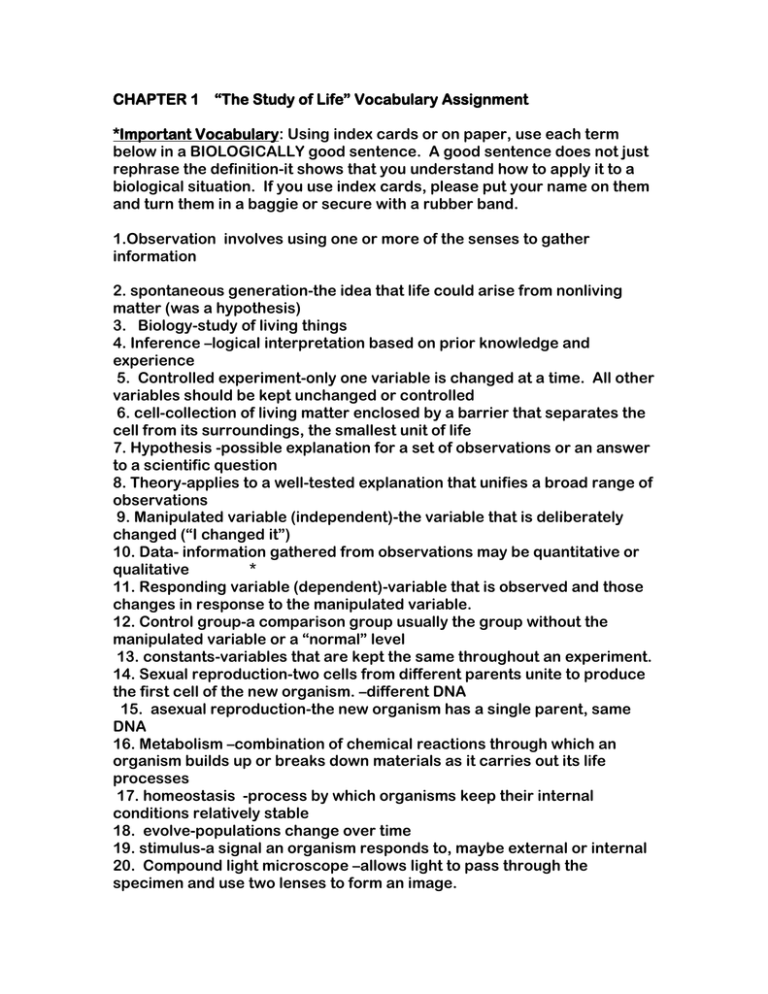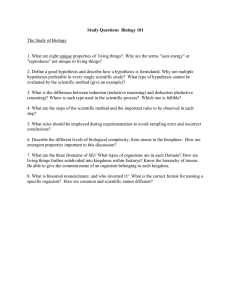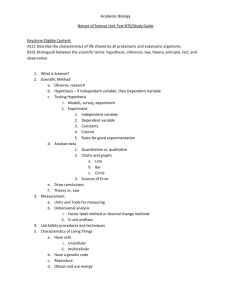CHAPTER 1 “The Study of Life” Vocabulary... *Important Vocabulary: Using index cards or on paper, use each...
advertisement

CHAPTER 1 “The Study of Life” Vocabulary Assignment *Important Vocabulary: Using index cards or on paper, use each term below in a BIOLOGICALLY good sentence. A good sentence does not just rephrase the definition-it shows that you understand how to apply it to a biological situation. If you use index cards, please put your name on them and turn them in a baggie or secure with a rubber band. 1.Observation involves using one or more of the senses to gather information 2. spontaneous generation-the idea that life could arise from nonliving matter (was a hypothesis) 3. Biology-study of living things 4. Inference –logical interpretation based on prior knowledge and experience 5. Controlled experiment-only one variable is changed at a time. All other variables should be kept unchanged or controlled 6. cell-collection of living matter enclosed by a barrier that separates the cell from its surroundings, the smallest unit of life 7. Hypothesis -possible explanation for a set of observations or an answer to a scientific question 8. Theory-applies to a well-tested explanation that unifies a broad range of observations 9. Manipulated variable (independent)-the variable that is deliberately changed (“I changed it”) 10. Data- information gathered from observations may be quantitative or qualitative * 11. Responding variable (dependent)-variable that is observed and those changes in response to the manipulated variable. 12. Control group-a comparison group usually the group without the manipulated variable or a “normal” level 13. constants-variables that are kept the same throughout an experiment. 14. Sexual reproduction-two cells from different parents unite to produce the first cell of the new organism. –different DNA 15. asexual reproduction-the new organism has a single parent, same DNA 16. Metabolism –combination of chemical reactions through which an organism builds up or breaks down materials as it carries out its life processes 17. homeostasis -process by which organisms keep their internal conditions relatively stable 18. evolve-populations change over time 19. stimulus-a signal an organism responds to, maybe external or internal 20. Compound light microscope –allows light to pass through the specimen and use two lenses to form an image. Chapter 1 vocab. assignment Part 2-use each term below in a Biologically good sentence! Due 9/16, 9/17 21. Electron microscope-focus beams of electrons on specimens, TEMtransmission-through a specimen, SEM- scanning-electrons back and forth across the surface. Only dried out and dead specimens. 22. Cell culture-a group of cells develops from a single original cell 23. Cell fractionation-separation of cell parts using a centrifuge Important Scientists 24. Aristotle –made observations about the natural world, thought that “vital” forces brought some living things into being from nonliving material 25. Francesco Redi-1668-tested the hypothesis of biogenesis by a controlled experiment using meat, refuted the hypothesis of spontaneous generation 26. Anton Leeuwenhoek -prepared first lenses to magnify tiny objects, referred to as “animalcules 27. John Needham-tried to disprove Redi’s experiment, with heated gravy, claiming the heat killed anything alive and said the gravy produced the “animalcules” 28. Lazzaro Spallanzani-improved Needham’s experiment, heated and sealed one flask,supported Redi’s hypothesis 29. Louis Pasteur- designed experiment with a curved neck flask, so both open to the air, but couldn’t come from the air-disproved hypothesis of spontaneous generation, supported the theory of biogenesis. Branches of Biology 30. Botany-scientific study of plants 31. Genetics-science of genes, heredity and the variation of organisms 32. Biochemistry-explores the chemistry of living organisms and the molecular basis for the changes occurring in living cells. Anatomy-branch of natural science dealing with the structural organization of living things. 33. subdiscipline of biology that studies all aspects of the cell. 34. Ecology-study of interactions of organisms with one another and with the physical and chemical environment. 35. Zoology-the study of animals 36. Paleontology-study of ancient life forms that inhabited our earth and of the fossils that remain behind. 37. Cryobiology-branch of biology that studeis the effects of low temperatures on living things 38. Taxonomy-the science of organizing and naming living things 39. Microbiology-study of microorganisms 40. Ethology-study of animal behavior *Important questions (answer on separate paper in complete sentences). 1. What is the difference between an observation and inference?(pg.4) 2. Compare qualitative and quantitative observations.(pg.4) 3. Why is Redi’s experiment on spontaneous generation a controlled experiment?(pg.9) 4. How did the design of Pasteur’s flask help him refute the hypothesis of spontaneous generation?(pg.12) 5. List AND describe the characteristics of living things.(pg.16) 6. Describe the Levels of Organization in the study of Biology. Choose an organism and identify the levels of organization that characterize it and its environment.(pg.21) 7. What happens to an organism if its homeostasis is disrupted and not restored?(think!) 8. Why do scientists use a common measurement system?(pg.24) 9. What is the difference in the way light microscopes and electron microscopes produce images?(pg.25) 10. What types of objects can be studied with a light microscope? An electron microscope?(pg.26) 11. List and describe the 5 most important lab safety rules.(pg.28 and think!) *Labs and Activities: What is Life Lab, data game, designing experiments, microscope activity/lab, metric scavenger hunt, safety video/activity, Biology in Your Life, Biology Current Events *Quizzes on microscopes, metrics, vocabulary, experiments, lab safety, vocabulary *Chapter 1 TEST –to be given on:_____________________ Biology Current Event due:__________________________


